
Find the perfect fit with Amazon Prime. Try Before You Buy.

Charles the Bold, the warlike last Duke of a powerful independent Burgundy, was the chief military innovator of the late 15th Century, and his armies show very clearly the beginning of the transition between feudal levies (albeit paid) and independent mercenary bands, and the emerging standing armies of the new age. They were the first army to be placed on a largely regular footing, contained numbers of specialist mercenaries, made large-scale use of both artillery and hand firearms, and Charles' military Ordinances, demanding strict discipline and, another innovation, regular drilling and exercising of the troops, became the basis for those of many 16th Century armies.
Charles in fact started with basically feudal forces, found, like the English and French before him, that they must be paid in order to be kept on foot for a lengthy campaign, and, in 1471, took the further step to a standing army, by forming 'Compagnies d'Ordonnance' of 600 men-at-arms, on similar lines to the French. These, increasing to over 1,700 by 1476, formed the chief strength of the Burgundian army. As was usual, they were formed into companies, each of 100 'lances', in the Burgundian case sub-divided into four squadrons of 25. A 'lance' consisted of the Gendarme or man-at-arms, fully-armoured and equipped with a heavy lance (Burgundian ones were supposed to have at least frontal armour for the horse and seem sometimes to have had shields); a coustillier - in this case armed with javelin and sword and thus perhaps intended to act as a light cavalryman; a page; and no less than three mounted archers: in Charles the Bold's army these were still mounted infantry, not the cavalrymen they afterwards became, even their secondary weapon - a two-handed sword - being unsuitable for mounted use. Many of them were English longbowmen. The archers operated separately from the men-at-arms, in their own 100 man companies, the 'lance' in fact, in this army as others, being a sort of administrative hangover from the feudal noble and his followers.
In his last campaigns, Charles added three infantrymen - a culverinier or hand-gunner, a crossbowman and a pikeman - to each lance, but again they would operate separately, and this was more of an administrative measure, showing that the bulk of the army, infantry as well as cavalry, had become regular, paid, troops - 'of the Ordinance'.
Burgundian feudal levies still remained, and Charles hired various mercenaries: apart from the English longbows mentioned, there were French men-at-arms, German hand-gunners, and large numbers of Italians (including Savoyards - Savoy being at first an ally and later almost a satellite of Burgundy). The Italians included men-at-arms, mounted crossbowmen, and infantry; in the later years they formed a very large part of the army, and Charles formed one 'battle' entirely of Savoyards, another of Italians.
In his earliest wars, Charles had levied Flemish citizen pikemen, equipped with jack and sallet helmet, from the towns of the Low Countries. Though they had in the past scored victories over men-at-arms, they were a military disappointment, and as argumentative and unwilling as the feudal men-at-arms, so were replaced in later years by mercenary pikemen, some of them probably from the same area. To judge by pictures, these latter were rather more heavily armoured, but still failed to stand up to the Swiss.
The Infantry of the Ordinance were organised in 1,000 man companies, which were possibly tactical units, though in 1476, when Charles divided his army into eight 'battles', six of these consisted of a centre of 500 infantry with cavalry wings. The infantry, as distinct from the mounted archers, were probably supposed to be of equal numbers of pikemen, hand-gunners, and crossbowmen, but in 1472 at least, the pikes were up to strength, but the hand-gunners only a third, and the archers only half, their number. On occasion the pikes and archers were intermingled, by fours, in action, though the pikes were also trained to form up in front, kneeling down, with the archers shooting over them.
Charles' army, finally, contained a Ducal 'Household' of over 2,000 men, which eventually consisted of, firstly, eight 50-lance companies of men-at-arms, four being of the bodyguard, four of the Court; secondly, their corresponding archers, all English, about 800 strong; thirdly, eight 100-man companies of Household infantry (half 'ordinary', half 'extraordinary'); and fourthly, a company of 40 Gentlemen of the Chamber, guarding the Duke's standard.
As might be expected in this early period, figures for the overall strength of the Burgundian army are rather conflicting, but shortly before the disastrous defeat of Morat, 1476, his army consisted of: 1,741 men-at-arms (including 500 of the Household); 4,062 mounted archers including 1,377 English; probably also mounted crossbowmen); and 4,445 infantry: 10,248 total. However, Burgundian feudal levies and Savoyards would bring this up to something between 12 and 15,000 altogether.
In addition to horse and foot, Charles brought into the field a great quantity of artillery; he was not the first commander to do so, and its presence was partly due to the fact that he made a practice of being caught by the Swiss while undertaking sieges, but a 'modern' feature was the use of considerable numbers of handy light pieces on wheeled field carriages; a few guns even had trunnions, though the majority were rigidly attached to their carriages, some of which, known as 'Burgundian carriages', had built-in provision for elevation and depression. Many of the lighter guns also used the latest iron cannon balls.
Alas for Charles; with all his genius for organisation and military zeal, his career as general, once he came up against the Swiss, was one of unbroken disaster, contributed to both by his own rashness, and by a certain lack of enthusiasm and cohesion in his multi-lingual army. Charles' misfortune is, in a sense, our gain, however, for the victorious Swiss captured, and have largely preserved or recorded, an extraordinary mass of booty which constitutes a unique body of military evidence from this period.
Charles seems to have aimed at a degree of uniformity, at least among the troops of the Ordinance. The men-at-arms were ordered to wear blue and white plumes (the Ducal colours) and were supplied with red crosses of Burgundy, made of velvet, to attach to their armour. The Coustiliers and archers were given surcoats half white and half blue, again with the red cross, and there is evidence from the end of the reign that infantry of the Ordinance also wore blue and white Ducal uniform.
The red cross of Burgundy, strictly two ragged staffs' crossed, but also appearing as crossed arrows or a red 'X', would probably be worn by other troops as a field sign, and appeared on most of the flags. On the latter, the other universal emblem was a stylised flint-and-steel, usually emitting sparks.
The Duke evidently also wished to standardise flags; the companies of men-at-arms had cornets of the type shown; each company ensign had its own saint and colour, and the squadron cornets followed the same pattern, but with one gold 'C' for the first squadron, two for the second, and so on. Unit numbers also appear on some flags.
A favoured symbol was St George and the dragon; shown on a guard cornet, it also appeared early in the reign on Charles' chief standard, which was then white, and also carried the cross of Burgundy, plus flames etc, and Charles' motto 'Je l'ay emprins' (I have undertaken it). Heraldic banners of individual vassals, or carrying the arms of Charles' territories, were also common, and examples are shown.
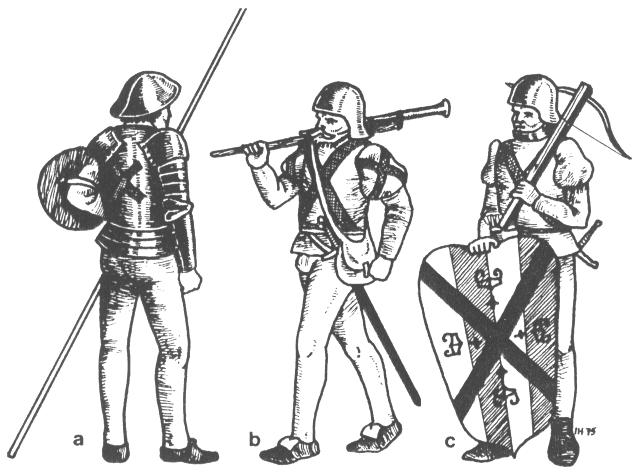
a Burgundian pikeman wearing corselet with large pauldrons and short fauld. In accordance with regulations, his right arm is armoured, his left not, but bearing a small buckler. His rather low-crowned pot helmet is perhaps linked with his Flemish origin, (Contemporary pictures do not necessarily show shields in use). b Burgundian hand-gunner carrying a primitive 'culverin'. His tunic has red crosses on sleeves, chest and back. Tight hose with prominent codpiece. Soft leather shoes with flap at front. Knapsack rather than later bandolier. From his 'barbute' type of helmet, he could be an Italian. c So could this crossbowman. His shield is about three feet high and nearly two feet wide at the top. It is made of wood, covered in leather, and has red and white stripes. The cross is probably a darker red, and the flint-and-steels probably gold.
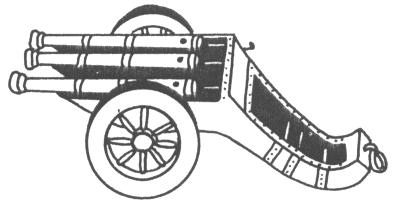 An organ-gun from Charles the Bold's army, based on a Swiss drawing. Single-barrelled guns are also shown on similar carriages. |
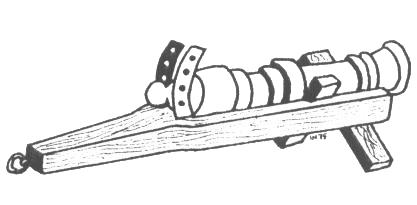 A light gun on simple trestle carriage with provision for elevating, also from a Swiss drawing. |
The Memoirs of Philip De Commines, Lord of Argenton: Containing The Histories of Louis Xi and Charles VIII. Kings of France and of Charles The Bold, Duke of Burgundy. |
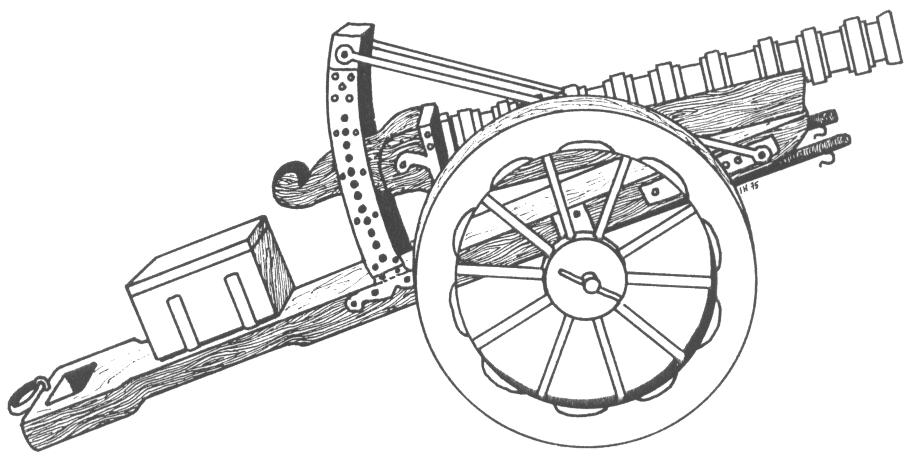
One of Charles the Bold's guns. This shows the 'Burgundian' carriage. Gun is about 75 mm calibre, overall length 360 cm, overall width 158 cm, wheel diameter 112 cm. Far wheel omitted for clarity.
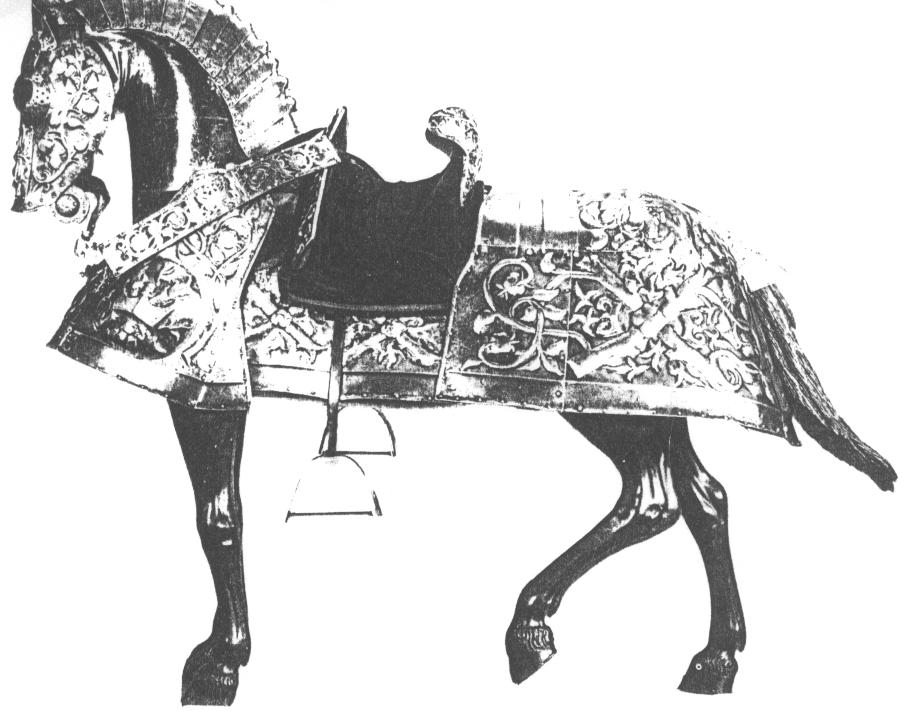
Burgundian horse armour (Bard) of the 16th Century (Tower of London).
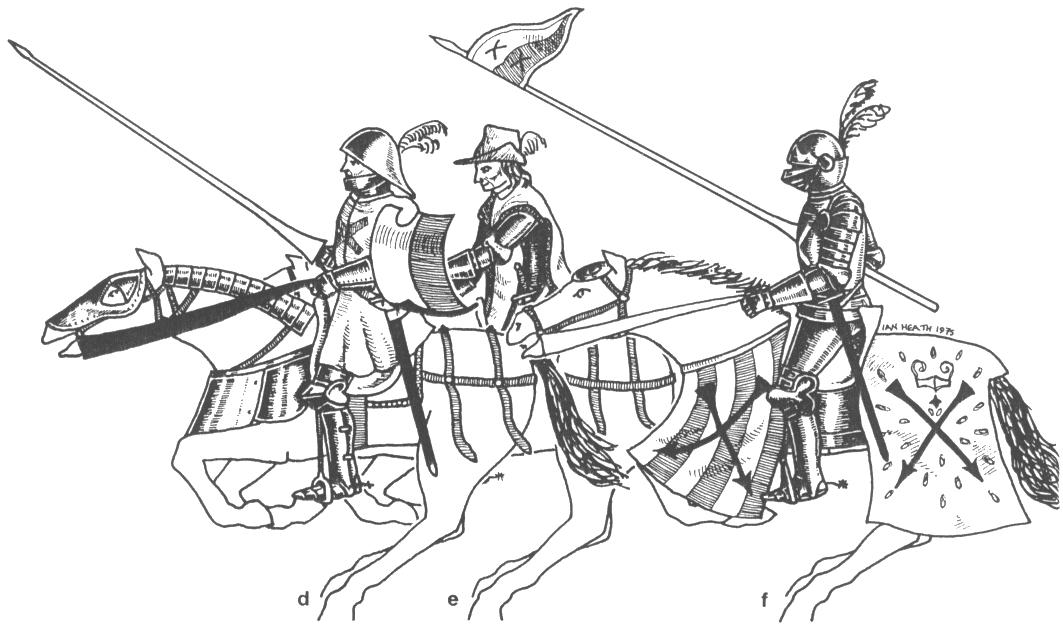
d Man-at-arms in sallet and carrying the concave shield with notch for lance still sometimes borne at this time, according to contemporary illustrations. He wears a surcoat with the cross of Burgundy. His horse has regulation frontal armour. e A mounted trumpeter in armour but with hat and tabard-type garment. f Man-at-arms wearing armet with visor and blue and white plumes. His horse has plate armour under the cloth bard, but has no head or neck armour except a small round plate on the forehead. Colours of bard unknown. Pennon (which is genuine, but does not necessarily go with this bard) is blue over red with crosses in reversed colours. Red cloth cross on breastplate.
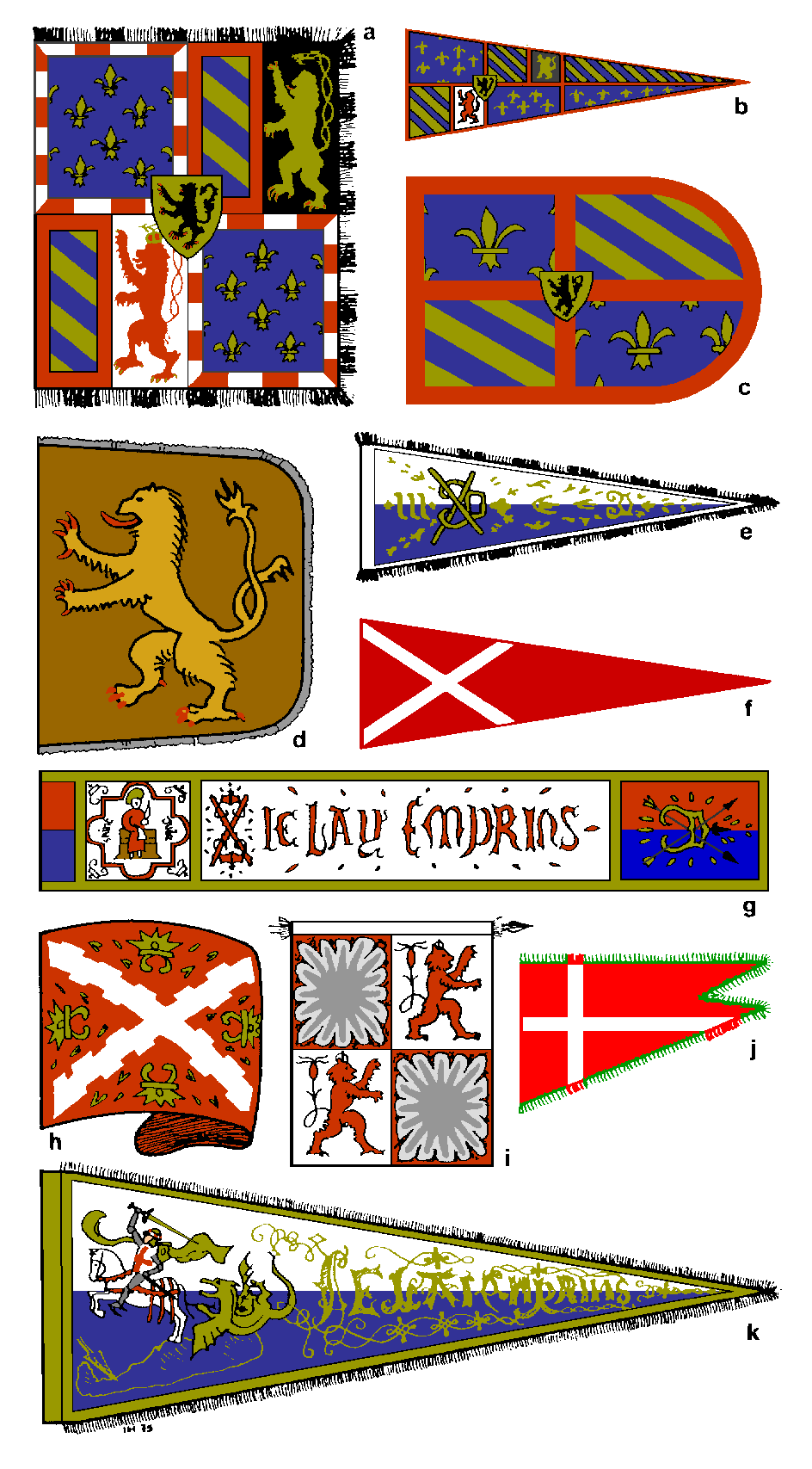
Burgundian flags. a Chief banner. Top left and bottom right, New Burgundy - blue, gold fleurs de lys, red and white border. Top right, Old Burgundy - blue and gold stripes with red border; Brabant - gold lion with red tongue and claws, on black. Bottom left, Old Burgundy as above; Limburg - red lion, gold claws and crown, on white. Centre shield, Duchy of Flanders - black lion with red tongue and claws, on gold. Fringe probably blue and white. b Cornet or pennon with arms of Burgundy.
c Another version. Border and cross probably red. d Flanders lion. Gold, with red claws and tongue. Flag dun-brown, fringe red, blue, yellow and green. Possibly a Flemish pikeman's flag(?). e Pennon in blue and white, all flames and devices, including company number III, are gold. f Possibly a lance pennon. Red with white cross. g A cornet with the image of Saint Jude, motto 'Je Lay Emprins' and crossed staves and arrows of Burgundy, entwined with flint-and-steel symbol. This basic pattern seems to have been used by the companies of Gendarmes d'Ordonnance, but with different colour and saint for each company. Here St Jude wears red, holds a white prayer in his right hand, and sits on a brown chair, all on a white base bordered red. His name is in black. The ground of the next part is white, all markings in red. Both ends of the flag are red over blue, the device on the right gold, as is the border of the flag. h Probably an infantry flag. Captured at Grandson. Red, with white cross. Flames, flint-and-steels probably gold. i banner of Jacques de Luxembourg (83 cm by 100,8 cm). Note odd angle of flag relative to staff. Lion red, crown etc gold, an white. 16-pointed star silver on red. There would have been a number of nobles' flags like this one. j A flag of Savoy troops in Charles the Bold's army. Red with white cross. Fringe green except at ends of cross, where it is red. k Burgundian banner of St George, probably a Guard standard. Top half of flag is white, bottom blue. St George has black armour, natural face, white surcoat with red cross and gold centre, a gold helm wrapped with a red and white 'turban', gold cloak and sword. Horse is white with red harness and gold trim. Ground on which horse stands, dragon and inscription ('Je Lai Emprins'), and flag edge all gold.
|
Renaissance Warfare by George Gush See also Burgundian Illustrations of Costume and Soldiers |